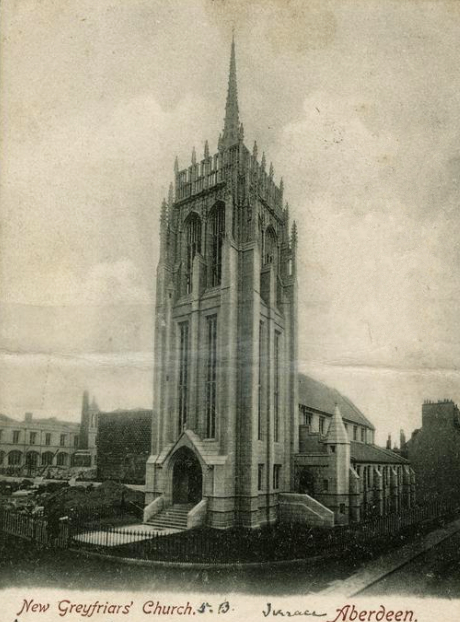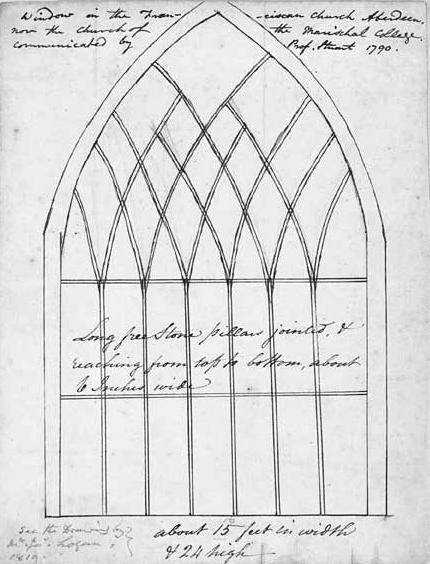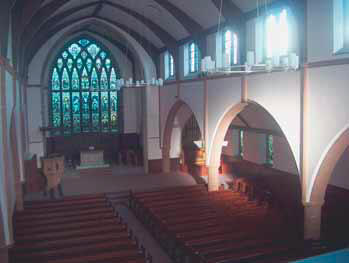New Greyfriars Church ~ 1903
It is now up for Sale uncleaned & unwanted. Plans were afoot to utilise it for yet another Bar & Restaurant
The current Greyfriars’ Church was Built in 1903 to replace the Medieval Predecessor of 1532, called the Kirk of Greyfriars. This earlier Church was Demolished to allow the Facade Construction of Marischal College. The Present Church was Designed by A Marshall Mackenzie in a Gothic Revival Style. It features a Tower, Rectangular Nave with a West Gallery & South Aisle (which features a Blind Arcade on its Northside). There is a Chancel with Organ Chamber on the Southside. The Church features a Hall Complex & Rooms Located Under the Church. At the East End is a Chapel with Internal & External Access. There is a Vestry which is reached by a Stair from the Church & Halls. There is also a Committee Room, Kitchen & Toilet Facilities, although Limited Disabled Access. The West Tower of the Church is joined on to the end of the College Facade that makes up a large part of the City Centre. The Tower is embellished with Sculptured Stone & Flying Buttresses which support a Fleche. The whole Structure (with the College Facade) is said to be the 2nd largest Granite Structure in the World, behind the Escorial near Madrid. The Interior of the Church has some interesting features. The Chancel incorporates Wood Panelling from the old East Church of St Nicholas. The East Window is highly Ornate & Traceried & survives from the earlier Church but with more recent Stained Glass. The Interior is lofty & spacious with a sweeping Central Aisle.
On 2nd September 1903, the present Greyfriars Building was Opened for Worship, in a Special Service conducted by the then Moderator of the General Assembly. The New Church replaced the Original 1532 Building, which stood at right-angles to the present one, across the front of Marischal College. For a long time, Students at Marischal attended the Church on Sunday, sitting in a Special “College Gallery”. This can be seen in the Painting prominently displayed in the Ante-room of the Church. The Pulpit in the old Kirk was in its Traditional 17thC position, halfway down the Long Wall. Also, the Great Window just had plain Glass & was partly hidden by another Gallery.
The Story of the Construction of the New Church is an interesting one. In 1886 the Session called a new Minister, Rev Gordon I Murray, who had not long Graduated BD (1882) from Aberdeen University. He was a Driving Force in Proposals to Revamp the Ancient Church building. However, the University had other ideas; it wanted to pull down the Old Church to make way for a big expansion, with a new Frontage on Broad Street replacing old Shops & Buildings. An Enabling Act was passed by Parliament in 1893. However, the Town Council (as it was then known) & the University had different views on the Location of the Rebuilt Church. There was also a Vociferous Campaign to retain the old Building, largely on Historic Grounds. The dispute even reached the Court of Session. Finally, the Town Council very generously bought & paid for the Present Site. This released the Log-jam in time for the University to Build its new Frontage & have a Delayed Celebration of its Quater Centenary, with King Edward VII, in person, Opening their New Buildings.
This was a few years after Greyfriar’s reopened. However, in June 1902, the Parties concerned (Town Council, University & Presbytery) celebrated their Agreement by laying the Corner Stone which can be seen in the Corner of the Vestibule. This tells of the Relationship to the Original Franciscan Friary (1469), which Vanished at Reformation (1560) when the Friars handed over their Building to the Town Council. It also tells how the Masonry of the South Window of the old Kirk was taken down and made into the frame of the new East Window. This wonderfully preserved a lasting memory of the old Building.
This Rough Sketch dated 1790 of the Tracery is quite inaccurate & may merely have been an overall Dimensional notation as the lower-left Comment suggests. This Sketch has been ‘communicated by Professor Stuart, 1790. Other notes on the Sketch read ‘Long Freestone Pillar Jointed, & reaching from the top to bottom, about 6-ins wide’ & at the bottom, ‘about 15-ft in width x 24-ft high’. A pencil note from a later date reads ‘See the Drawings by Mr J Logan, 1819‘. Logan was responsible for many Drawings of Aberdeen in the Hutton Collection. Marischal College, on the Site of a Franciscan Friary Founded in 1469, was Originally a Protestant alternative to King’s College in Old Aberdeen. The 2-Colleges United to form the University of Aberdeen in 1860. The modern Façade of the College Building was mostly Constructed in the 1890s, but the Window shown in this Sketch appears to have been part of a Church Incorporated into the College on its 16thC Foundation.
It may be mentioned that in the extreme North end of this Modern Granite Church there has been preserved the Freestone Tracery of the beautiful pre-Reformation Window that adorned the East end of Old Greyfriars Church. The Upper cusped work of this Window is looked upon as a Monument of the Genius of Architect Alexander Galloway, who Designed it, while its Cross (or Transom) Bar in the middle has been pronounced by Pugin to be probably unique in such a Window.

The 16thC Tracery Window has been Incorporated into the Present Church. ln fact, it greatly improved on the old window, because new Stained Glass was Commissioned from the Famous Artist Earner Kempe, whose Work can also be seen in English Cathedrals & in Govan Old Parish Church. He was Commissioned on the Advice of Sir George Reid, then President of the Royal Scottish Academy, whose father had been an Elder of the Church. The Design of the Stained Glass in the East Window was agreed with Rev Gordon Murray, who afterwards proudly Lectured on it. It showed the Connection with Town & University, through their Crests at the Ttop of the window, and with the Franciscans & Bishop Gavin Dunbar (Funder of the 1532 Church). It also showed the Crucifixion of Christ, dominating the Communion Table. The other great influence on the new Church Building was A Marshall Mackenzie, the Architect of the New Frontage of Marischal College. He very cleverly designed a Granite Tower & Spire for the New Church in keeping with the New Frontage. He was clearly influenced by the Gothic Revival movement that had dominated late Victorian Church Architecture. However, he also gave the Church a very light Airy Interior, with Sandstone Columns. 17thC Wooden Panels inscribed with Names & Dates were Incorporated into the Eastend of the New Church, the facing of the 1st-Floor Gallery & the Exterior of the South West Main Door. It is uncertain where these Panels originated but they may have come from the old Greyfriars Church or St Nicholas Kirk.
The Church Building was largely paid for by the Town Council, as it says in the Inscription in the East Window. Here the Session thanks “the Town Council, as Heritors of the Parish, in Erecting this Church & the unwearied efforts of their Minister, the Rev Gordon J Murray -”.
The Minister was later known as Dr Murray, on Account of the Honorary DD he received from his University in 1910. He had seen enormous changes in 25-yrs. In February 1902 they began to take down the South Window of the old Church, but only 18-months later the new Church was complete. Those old Edwardian Craftsmen & Masons could teach the current Builders a thing or two. Dr Murray’s Picture hangs at the back of the Side Aisle, together with Pictures of the Old Kirk, & of old & new Kirk Sessions.




